Carrot Top Chimichurri
Carrot Top Chimichurri is a food waste recovery recipe using carrot leaves instead of parsley in a traditional chimichurri recipe. Don’t toss those carrot tops, use them in interesting ways to reduce food waste!
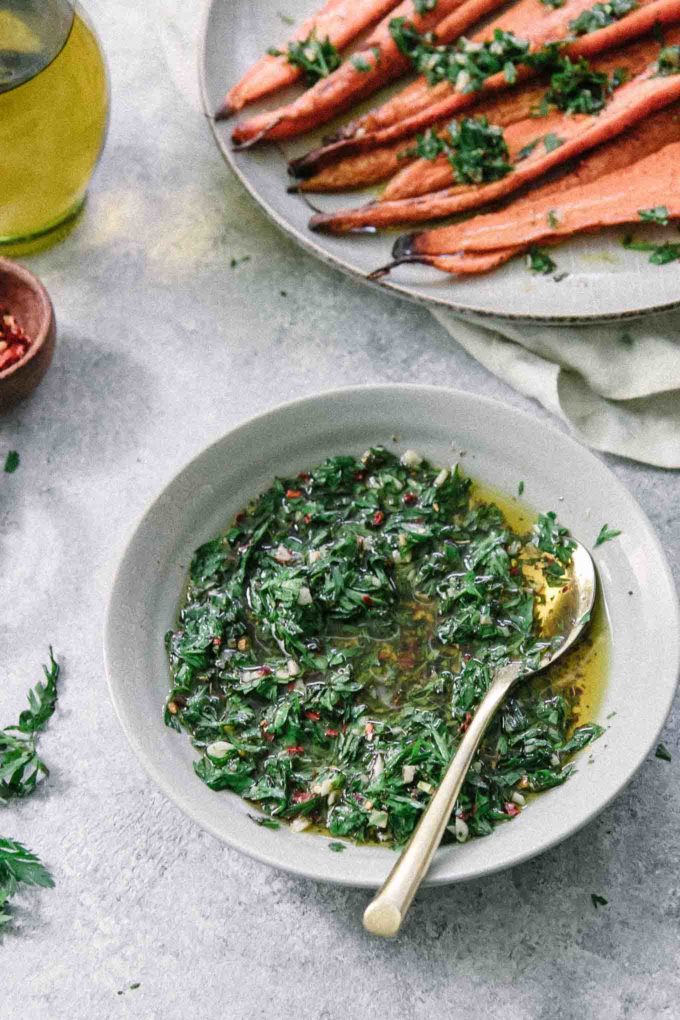
Want to Save This Recipe?
Enter your email & I’ll send it to your inbox. Plus, get new plant-based recipes in your inbox!
By submitting this form, you consent to receive emails from Fork in the Road.
Do you toss carrot tops? Most people don’t give a second thought to carrot leaves and throw them out without realizing carrot leaves are actually a deliciously edible green that’s delicious in sauces, salads, and soups.
Carrot tops are a great replacement for herbs like parsley in traditional sauces like and chimichurri. In fact, we’ve used carrot greens in pesto and even sautéed them with garlic and red pepper as a delicious side dish. The carrot top possibilities are endless!
To make a chimichurri using carrot tops, simple follow these three easy steps:
- Finely chop carrot greens and garlic
- Mix in a bowl with olive oil, red pepper, oregano, and red wine vinegar
- Add salt and pepper to taste
- Let sit 10 minutes, then serve!
Ready to learn how to reduce food waste AND make a delicious drizzling sauce? Let’s do it!
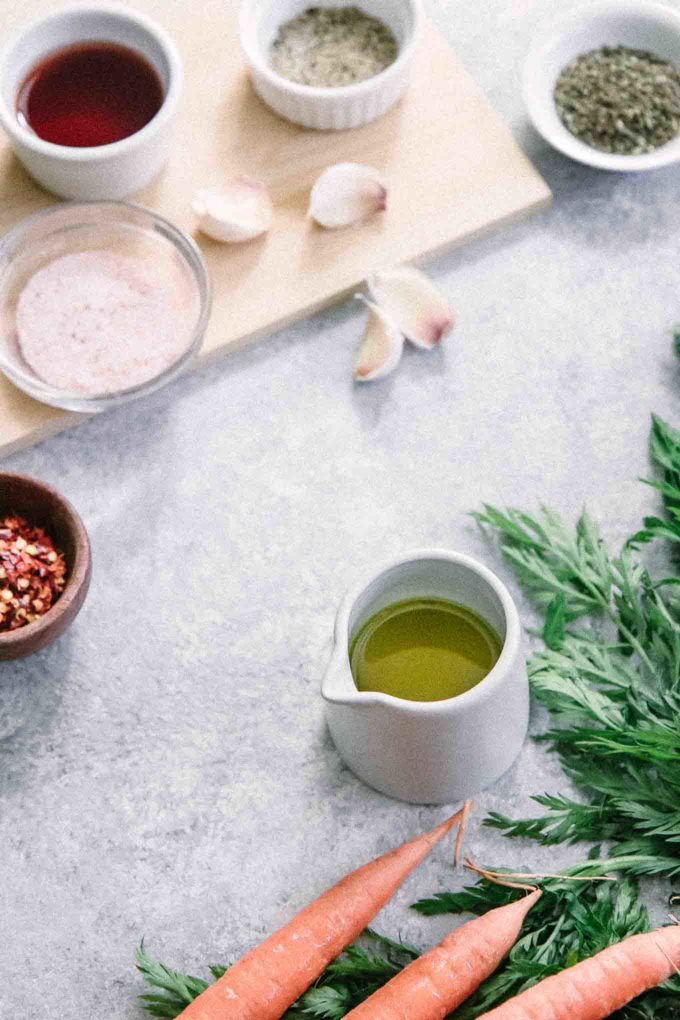
🥕 How to make chimichurri with carrot greens (step-by-step)
1️⃣ Step one: Finely chop ingredients and mix together in a bowl
The first step to making carrot greens chimichurri is to prepare the ingredients.
First, wash the carrot tops to remove excess dirt by washing them under running water or soaking them in a water-filled bowl.
Chop the washed and carrot tops and garlic until they’re very small. Because we’re not using a food processor or blender to make this chimichurri, we want to ensure all ingredient pieces are uniformly minced.
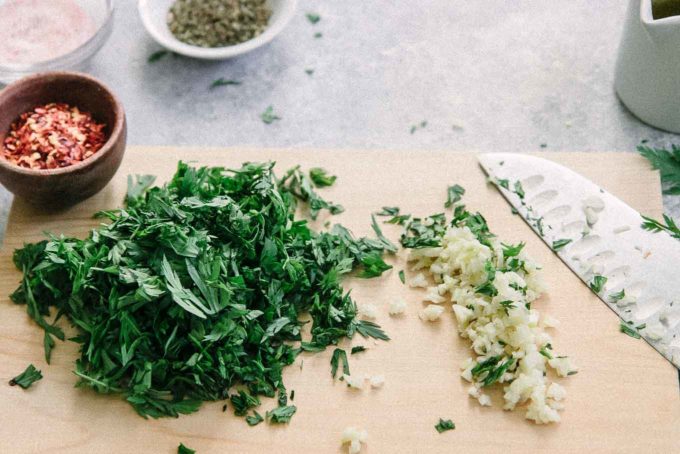
Next, add the chopped greens and garlic to a medium mixing bowl and stir in the red pepper flakes, dried oregano, red wine vinegar, and olive oil. Stir to combine.
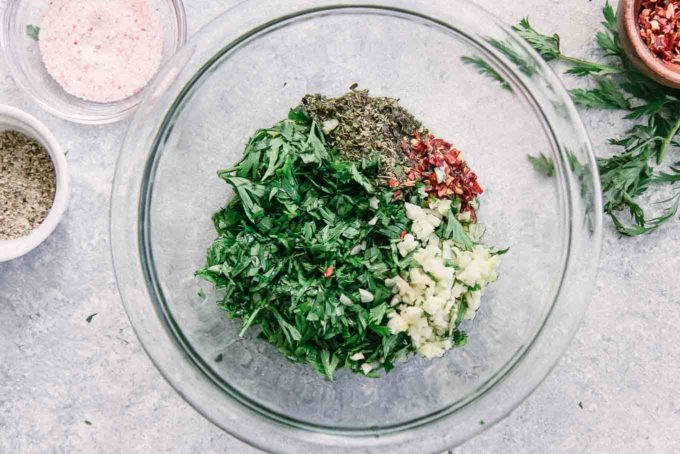
👉 Why not use a food processor or blender for chimichurri? Traditional chimichurri is a looser consistency, with small bits of herb, garlic, and spices suspended in oil — not a thick herb sauce like you would get when blended. You can use a food processor to pulse the dry ingredients into small pieces and then remove and add to a bowl and mix with oil after to get the right consistency. However, we don’t want to blend the oil and ingredients into a thick sauce.
2️⃣ Step Two: Add salt and pepper to taste
Next it’s time to add the salt and pepper. Estimated amounts of salt (½ teaspoon) and black pepper (¼ teaspoon) are provided in the recipe card below, but because each person’s salt sensitivity is different, we recommend adding them slowly and taste testing until you get the perfect amount.
The role of salt in this chimichurri recipe is to enhance the flavor of the herbs and spices, not overpower them. The taste of added salt will also get stronger as the sauce sits, so add a small amount and add more later if needed.
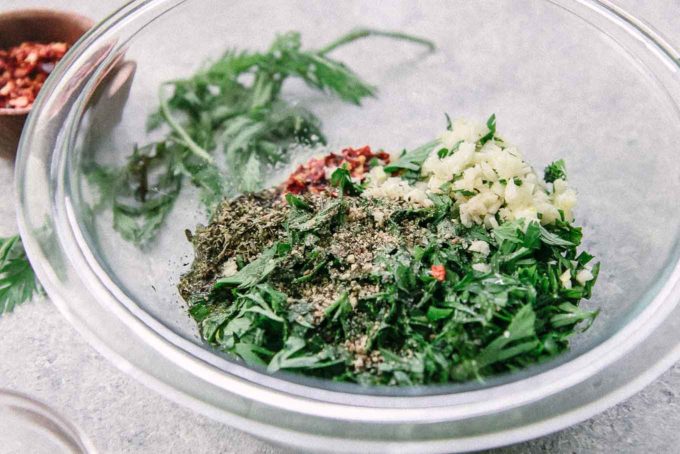
3️⃣ Step Three: Let sauce rest to enhance the flavor
The final step to making chimichurri is to do nothing — or rather, let the sauce sit so the ingredients combine and release their flavors. We recommend a minimum of 10 minutes, but for best results try making the chimichurri 30 minutes before serving.
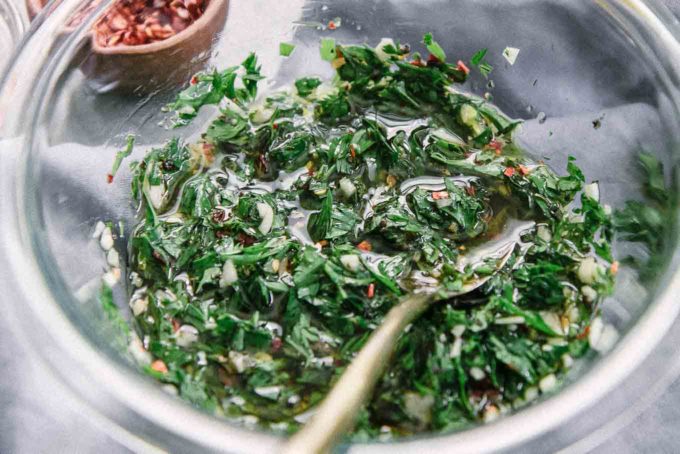
4️⃣ Step Four: Serve + enjoy!
Serve on top of roasted vegetables, plant-based burgers or sausages, mix into soups and stews, or as a dipping sauce for bread or raw veggies. Chimichurri can also be used as a marinade for vegetables that are roasted in the oven or grilled.
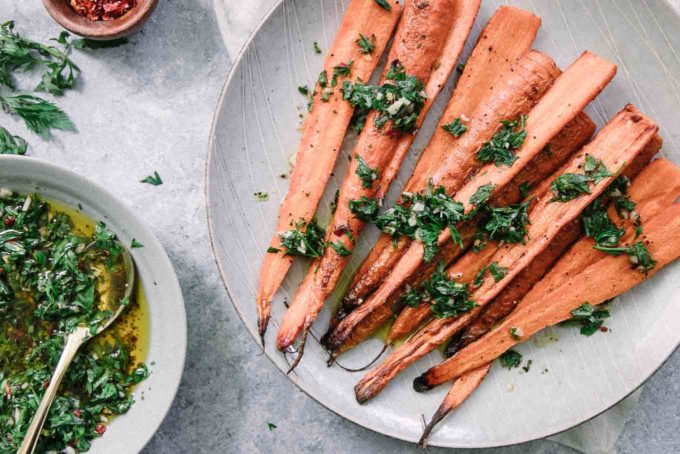
🌿 How to store chimichurri
If you’re making chimichurri ahead of time, or have leftovers after serving, follow these simple storage instructions:
- Store a room temperature for up to 4 hours: If you’re serving within 4 hours, the chimichurri sauce is fine to be covered and stored at room temperature.
- Store in the refrigerator for up to 3 days: If you’re serving the sauce later or have leftovers that will be eaten within three days, store in an airtight container in the refrigerator.
- Store in the freezer for up to one month: If you’re saving chimichurri to use for at a date later than three days ahead of time, freeze the chimichurri after it has had time to rest and release flavors. Store in an airtight container and freeze for up to one month. Thaw by setting sauce on the countertop for 1-2 hours. We do not recommend freezing again after thawing.
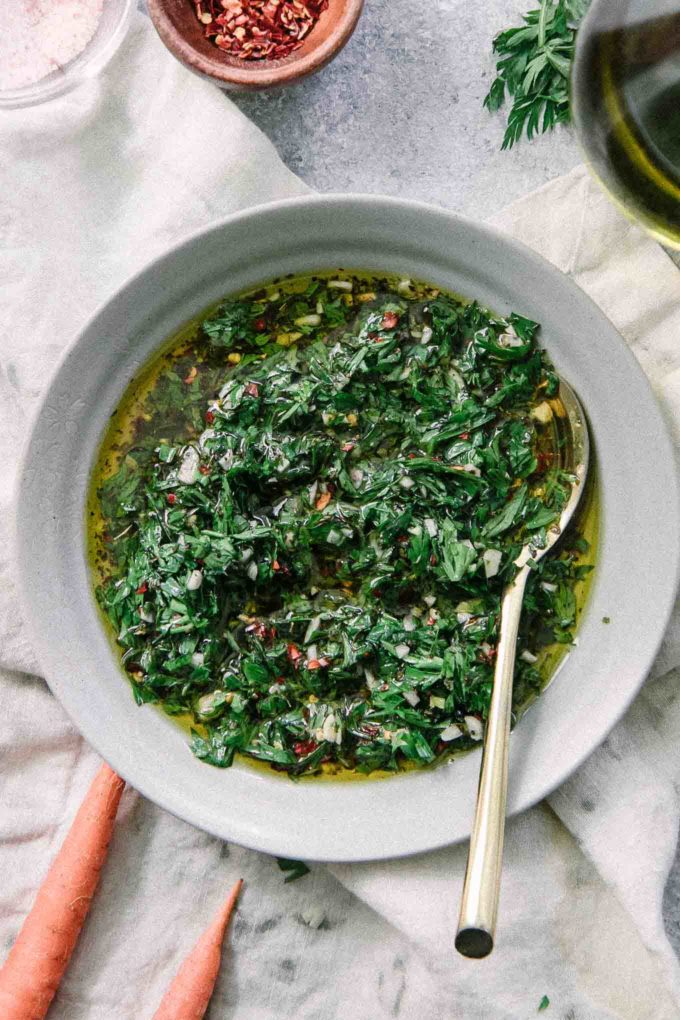
❓ Questions about cooking with carrot tops
Carrot tops are edible, in fact they’re delicious! Carrot tops are safe to eat and are not a poisonous vegetable. They do have a slightly bitter taste, so they are best paired with flavorful ingredients to cut the bite. Carrots are part of the Apiaceae or Umbellifera family, which also includes parsley and coriander (or cilantro). The stems of carrots can be tough, so we recommend only using the softest parts of the stems that are below the greens.
Carrot tops are a sturdy and slightly bitter green that is perfect for mixed salads, as an alternative to parsley or cilantro in soups or stews, or sprinkled on top of food as a garnish. Carrot leaves are also great in sauces like pesto or chimichurri.
Carrot leaves are a nutritious leafy green that are high in vitamin K, vitamin A, and have about 90 calories per serving (about 1 cup of chopped greens) (USDA Food Nutrient Database).
Carrot tops can be frozen for up to 2-3 months, possibly longer. It’s important to wash and completely dry the greens before wrapping a small cloth or kitchen towel and freezing in a freezer-friendly bag or container.
Traditional chimichurri sauces usually use fresh parsley and/or cilantro, but carrot tops can replace one or both of these herbs for a hearty, earthy flavor.
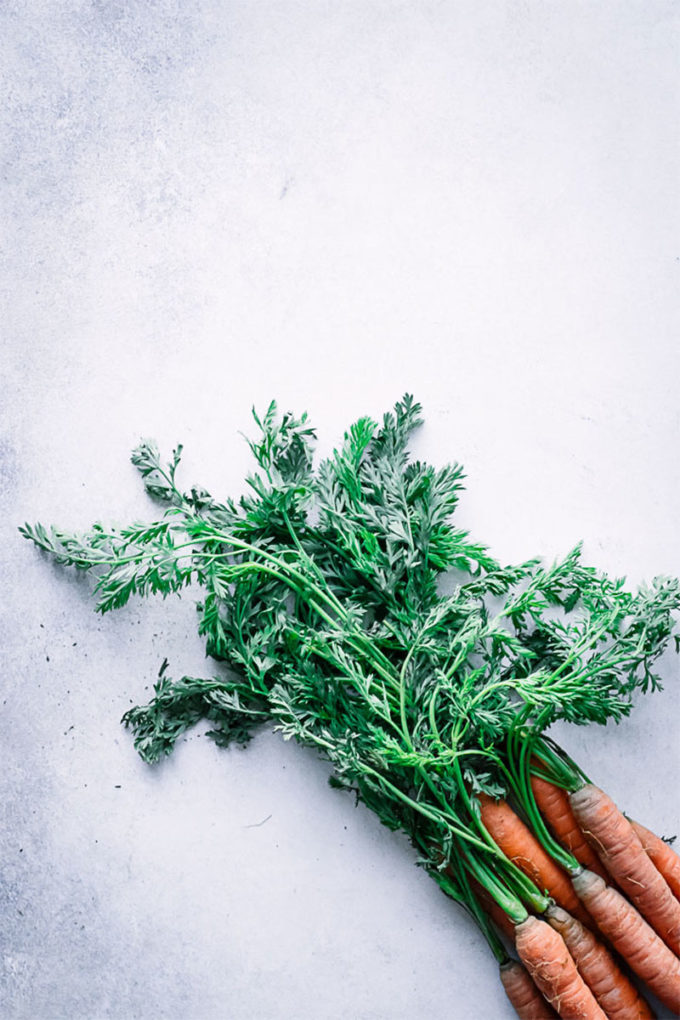
♻️ Sustainable kitchen + food waste recovery tips
While eating carrot greens is sustainable in itself since you are using food that would otherwise be wasted, there are a few tips and tricks you can learn to make this chimichurri recipe even more environmentally friendly:
Take advantage of carrot season! The best time to make recipes using carrot greens is during the height of carrot season. In California that’s actually year round, but check out Seasonal Food Guide’s produce seasonality calendar to find when green beans are in season near you. And read our full tutorial for storing carrots in the pantry, fridge, freezer, and even your basement or cellar.
Save carrot stems for soup broths. While carrot roots (the orange part we know and love) and carrot leaves are edible, the stems of carrots are sometimes tough and bitter-tasting. We recommend cutting the hard stems a bit below the leaves and saving the stem scraps to use in things like vegetable broth.
Check out our other food waste recovery recipes: Use leftover broccoli stems as a crunchy salad, use leftover sun-dried tomato oil in a salad dressing, and turn leftover celery into a delicious salad.
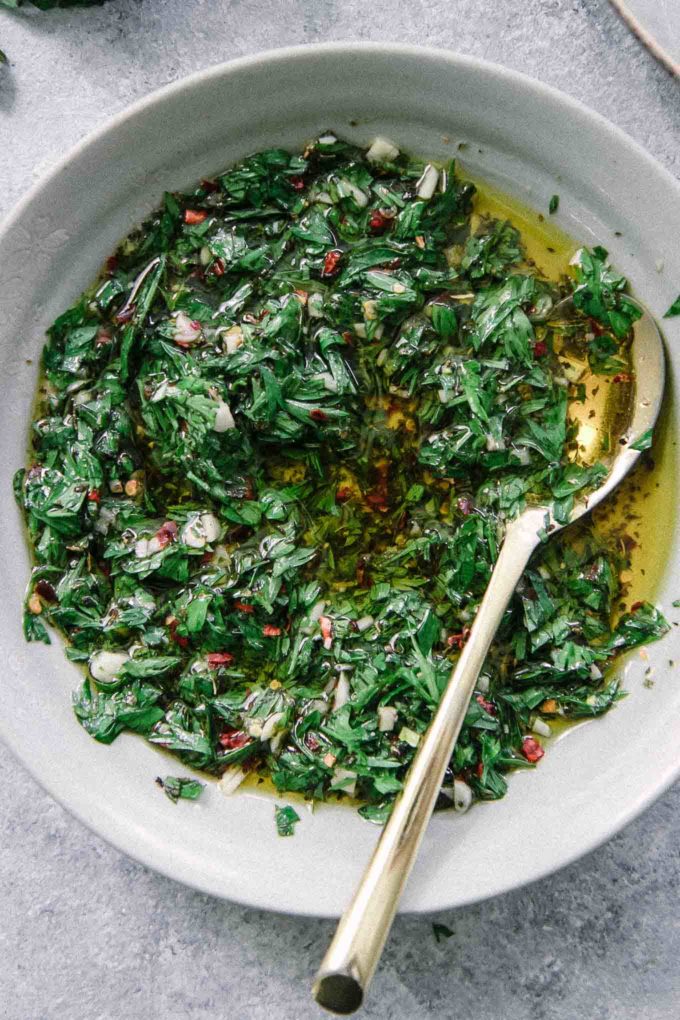
🌱 More recipes using carrot tops
Carrot leaves are great in sauces, soups, or even sauteed on their own! Check out our other plant-based recipes using carrot tops:
Looking for more alternative chimichurri recipes? Try our Radish Tops Chimichurri or Chimichurri with Beet Leaves.
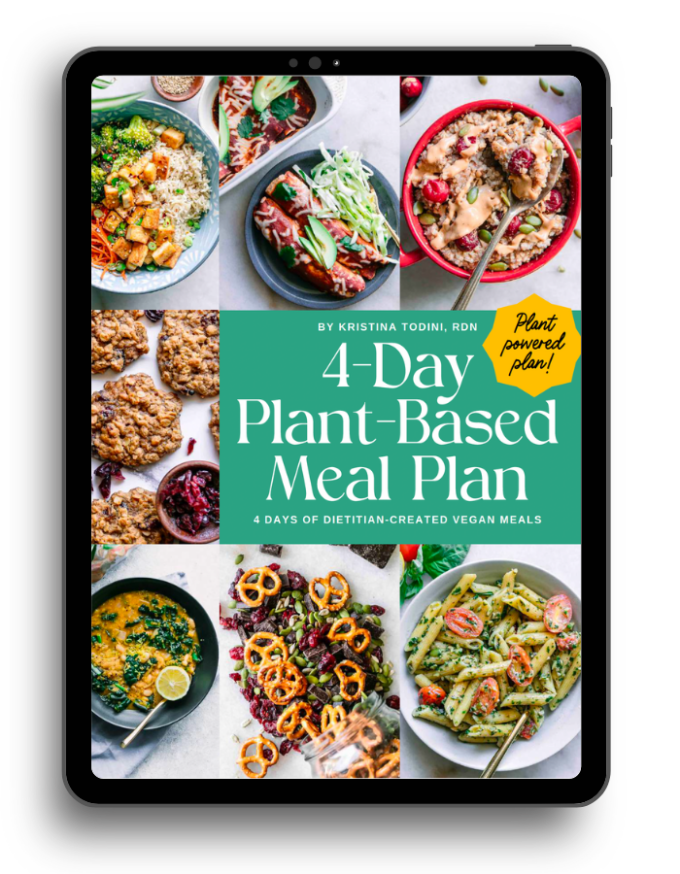
NOT SURE WHERE TO START WITH PLANT-BASED EATING?
Get my 4-Day Plant-Based Meal Plan to start your journey on the plant path.
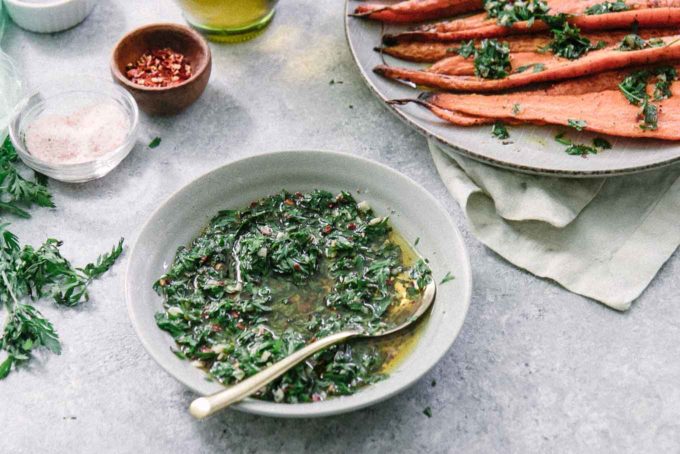
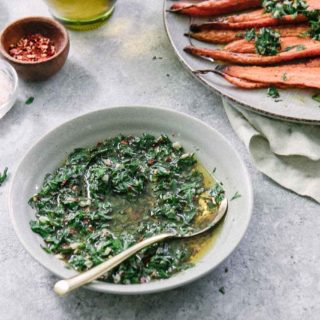
Carrot Top Chimichurri Recipe
Ingredients
- 1 cup carrot tops finely chopped
- 3-4 whole garlic cloves finely chopped
- 1 teaspoon crushed red pepper
- ¾ teaspoon dried oregano
- ½ cup olive oil
- 2 tablespoons red wine vinegar
- 1 teaspoon sea salt to taste
- ½ teaspoon black pepper to taste
- Optional: cumin, paprika, or lemon juice to taste
Instructions
- Combine ingredients: In a medium mixing bowl, combine the chopped carrot tops, dried oregano, chopped garlic, crushed red pepper, olive oil, and red wine vinegar.
- Season with salt and pepper: Slowly add the salt and pepper, stopping to taste test to ensure it’s not oversalted. Mix well to combine all ingredients.
- Let sauce rest: Let the chimichurri rest for a minimum of 10 minutes before serving, but for best results make the carrot top chimichurri 30 minutes ahead of serving so the flavors have time to reach their full potential.
- Serve: Serve on top of roasted vegetables, plant-based burgers or sausages, mix into soups and stews, or as a dipping sauce for bread or raw veggies. Chimichurri can also be used as a marinade for vegetables.
Notes
- Recipe notes: We highly recommend taking the time to finely chop all ingredients and mix together in oil rather than making the chimichurri in a food processor or blender. Traditional chimichurri is a looser consistency, with small bits of herb, garlic, and spices suspended in oil — not a thick herb sauce like you would get when blended. If you are using a blender, simply pulse the dry ingredients and then add to oil after to get the right consistency.
- Tools needed: kitchen knife set, glass mixing bowls
- Prep ahead and storage: Make the chimichurri up to 3 days ahead of time and store in the refrigerator until ready to serve. Remove from the cold refrigerator at least 30 minutes before serving to bring to room temperature. You can freeze chimichurri for up to one month, possibly more.
- Nutrition notes: Chimichurri nutrition information is estimated without optional ingredients.
Nutrition
UPDATE: This recipe was originally published in 2018 but updated in 2020 and again for clarity in January 2022.

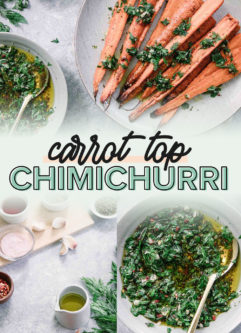
I’m really sorry if this is a dense question…but where can I find the actual recipe (loved and learned a ton from your post, I just cant find how to make it!)
Not a dense question at all! Thank you for pointing it out, I recently switched website themes and lost my previous recipe card data. I’m starting the long process of updating them all and this one slipped through the cracks. Thanks for letting me know and I hope you enjoy the recipe if you make it!
When and how much honey do you add? I’m missing the olive oil and honey glaze instructions.
Thanks for the comment, I went back in and revised the recipe. This recipe is a bit older and it needs a bit of revision so the instructions are clear, but hopefully my updates helped. Thanks!
Great recipe, I’ve heard about using carrot tops but have been unsure about how and when. Never would have imagined a carrot top chimichurri!
You can make carrot greens into anything! Carrot top pesto, chimichurri, or even just sprinkled on a salad with other lettuce greens. Enjoy!
I wish I could give this 10 stars. I found this recipe when looking for a way to use a bunch of carrot tops I had on hand before throwing them out. And I’m so glad I did. It’s delicious, and I’ve been putting it on so many foods, bread, egg sandwiches, etc. I’ll never throw them out again haha.
I’m so glad you liked it, Grace! This is one of my favorite recipes and I thought I was making chimichurri the right way until I learned the more authentic technique. Thanks so much for leaving a great review!